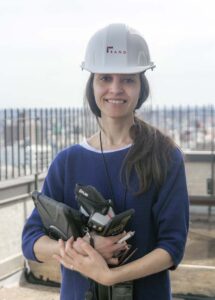 Image courtesy of Canva
Image courtesy of Canva
During this month's high avian migration period, approximately 400 million birds are currently on the move in the US. As architects, we cannot think of the built environment without recognizing its impact on the numerous bird species or the importance of mitigating these effects. New York City, situated on the Atlantic Flyway—one of the four major North American migration routes and the sole one on the East Coast—witnesses a tragic loss of life. The NYC Audubon estimates that as many as 230,000 birds die each year in the city due to glass collisions across the five boroughs.
In 2022, the City Council passed legislation aimed at reducing bird fatalities through the introduction of new bird-friendly building design and construction requirements, as well as mandating city buildings to turn off non-essential outdoor lighting during peak migration periods. While the City has made some strides in tackling the challenges faced by migrating birds, building owners and tenants can also contribute to their protection by adopting some straightforward measures:
Install Bird-Safe Glass or Decals
One of the leading causes of bird fatalities in urban environments is collisions with glass windows and buildings, often due to the reflections in the glass that confuse birds. Buildings undergoing restoration and window upgrade projects can consider integrating bird-safe glass and building design elements. One option is to use patterned or fritted glass, which is less reflective and more visible to birds.

RAND Senior Architect Valerie Landriscina encourages exploring resources on Wild Bird Fund and Audubon's websites for additional insights on enhancing the environment for the diverse bird species that share our urban spaces.
A quick and cost-effective method to prevent collisions is the use of window decals. Adhesive designs can be temporarily applied to existing windows and terrace railings to make them more visible to birds without sacrificing natural light or aesthetics. There are various decal options available, including UV-reflective decals that are nearly invisible to humans but visible to birds.
Additionally, creating patterns or artwork on glass using non-toxic tempera paint can serve as a lasting, easily removable solution that doubles as a fun family or school project, perfect for decorating windows for holidays and special occasions.
Turn Off or Dim the Lights
Light pollution poses a significant threat to migrating birds, as it can cause disorientation and result in collisions with buildings. By merely turning off or dimming lights at night, or adopting energy-efficient lighting techniques that minimize light pollution—such as using shielded outdoor light fixtures, motion sensors, and timers—we can contribute to turning off unnecessary lights during crucial migration periods, creating a safer environment for the various bird species that share our urban spaces.
Preserve and Enhance Green Spaces
Urban green spaces such as parks, gardens, and tree-lined streets offer crucial habitat for birds during their long journeys. Our firm is committed to preserving existing green spaces and incorporating additional vegetation into our building projects. By planting native species that provide food, shelter, and nesting opportunities, we can create urban oases for migrating birds.
Act Now
As our cities continue to grow and evolve, it is essential to take into account the needs of all urban inhabitants. RAND is dedicated to fostering a more sustainable environment for everyone, and as part of our ongoing efforts, we pledge to dim our office lights during nighttime hours, contributing to a safer urban landscape for both humans and wildlife alike.
For more ideas on how to support the safe migration of birds, please visit the Wild Bird Fund.
____________________________________________________________
Valerie Landriscina, RA is a Senior Architect on RAND’s Facade & Roofing Team, and an avid birder.
